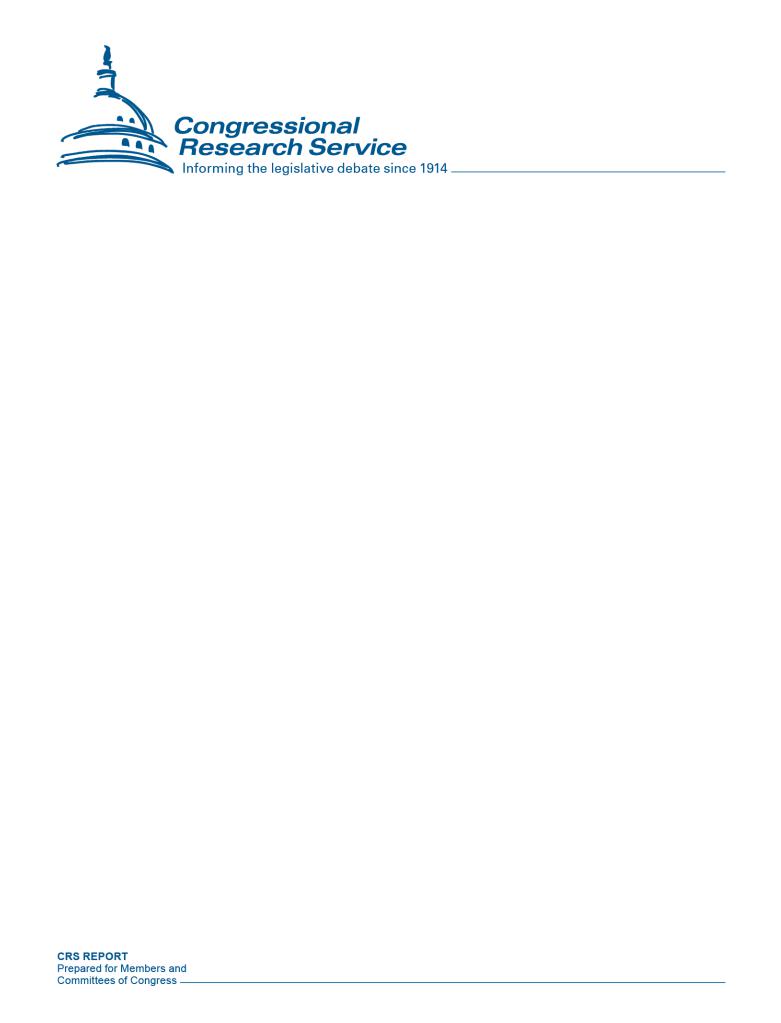
Афганистан CRS
.pdf
Afghanistan: Post-Taliban Governance,
Security, and U.S. Policy
Kenneth Katzman
Specialist in Middle Eastern Affairs
January 20, 2015
Congressional Research Service
7-5700 www.crs.gov
RL30588

Afghanistan: Post-Taliban Governance, Security, and U.S. Policy
Summary
As of January 1, 2015, the United States and its partner countries have completed a transition to a smaller post-2014 mission consisting mostly of training the Afghanistan National Security Forces (ANSF), which lead security operations throughout the country. The number of U.S. forces in Afghanistan, which peaked at about 100,000 in June 2011, has been reduced to just over 10,000, of which most are trainers and advisers as part of a 13,000 NATO-led “Resolute Support Mission.” About 1,000 of the U.S. contingent are counter-terrorism forces that also operating under a new U.S. “Operation Freedom’s Sentinel” that replaces the post-September 11 “Operation Enduring Freedom.” President Obama directed in May 2014 that the U.S. force will shrink during 2015 to about 5,000 by the end of this year, and their presence after 2015 will be exclusively in Kabul and at Bagram Airfield. The post-2016 U.S. force is to be several hundred military personnel, under U.S. Embassy authority. However, doubts about the ability of the ANSF to operate without substantial international backing have led to recent U.S. alterations of the post2014 U.S. rules of engagement and debate over the size of the post-2016 force.
Deploying a post-2014 international force was contingent on Afghanistan’s signing a Bilateral Security Agreement (BSA) with the United States and a similar document with NATO. These accords were delayed by a dispute over alleged fraud in the 2014 presidential election, which was settled in September 2014 by a U.S.-brokered solution under which Ashraf Ghani became President and Dr. Abdullah Abdullah was appointed to a new position of Chief Executive Officer of the government. Even though the election dispute was resolved, at least for now, experts remain concerned that Afghan stability is at risk from weak and corrupt Afghan governance. Ghani and Abdullah’s disagreements over new Cabinet selections delayed the appointment of a new cabinet until early January 2015. Aside from the tensions between Ghani and Abdullah, governance is widely assessed to suffer from widespread official corruption. Since taking office, Ghani has signaled he will prioritize anti-corruption issues.
An unexpected potential benefit to stability could come from a negotiated settlement between the Afghan government and the Taliban and other insurgent groups. Some negotiations have taken place periodically, and in May 2014 indirect U.S. – Taliban talks produced an exchange of prisoners that included the return of U.S. prisoner of war Sergeant Bowe Bergdahl. Ghani’s trips to Saudi Arabia, Pakistan, and China since taking office have been intended, at least in part, to invigorate negotiations. Persuading Afghanistan’s neighbors, particularly Pakistan, to support the reconciliation process has shown some modest success, although Afghan insurgent groups continue to operate from Pakistani territory. Yet, Afghanistan’s minorities and women’s groups fear that a settlement might produce compromises with the Taliban that erode human rights.
As part of a longer term economic strategy for Afghanistan, U.S. officials seek greater Afghan integration into regional trade and investment patterns as part of a “New Silk Road,” and say that Afghanistan might be able to exploit vast mineral resources. Still, Afghanistan will remain dependent on foreign aid for many years. Through the end of FY2013, the United States provided nearly $93 billion in assistance to Afghanistan since the fall of the Taliban, of which more than $56 billion has been to equip and train Afghan forces. The appropriated U.S. aid for FY2014 is over $6.1 billion, including $4.7 billion to train and equip the ANSF, and the FY2015 request is about $5.7 billion. These figures do not include funds for U.S. military operations in Afghanistan. Administration officials have pledged to Afghanistan that economic aid requests for Afghanistan are likely to continue roughly at recent levels (about $1.5 billion per year) through at least FY2017. See CRS Report RS21922, Afghanistan: Politics, Elections, and Government Performance, by Kenneth Katzman.
Congressional Research Service

Afghanistan: Post-Taliban Governance, Security, and U.S. Policy
Contents |
|
Background...................................................................................................................................... |
1 |
From Early History to the 19th Century ..................................................................................... |
1 |
Early 20th Century and Cold War Era ........................................................................................ |
1 |
Soviet Invasion and Occupation Period..................................................................................... |
2 |
The Seven Major “Mujahedin” Parties and Their Activities............................................... |
3 |
Geneva Accords (1988) and Soviet Withdrawal........................................................................ |
3 |
The Mujahedin Government and Rise of the Taliban................................................................ |
4 |
Taliban Rule (September 1996-November 2001)...................................................................... |
5 |
U.S. Policy Towards the Taliban During Its Rule/Bin Laden Presence .............................. |
5 |
The “Northern Alliance” Congeals...................................................................................... |
6 |
Bush Administration Afghanistan Policy Before September 11................................................ |
7 |
September 11 Attacks and Operation Enduring Freedom.......................................................... |
7 |
U.N. and Congressional Authorization for Use of Military Force (AUMF) ....................... |
7 |
Major Combat Operations: 2001-2003................................................................................ |
8 |
Post-Taliban Governance Established................................................................................. |
8 |
U.S. and International Civilian Policy Structure............................................................... |
11 |
Security Policy: Transition, and Beyond ....................................................................................... |
12 |
Who Is “The Enemy”? Taliban, Haqqani, Al Qaeda, and Others............................................ |
13 |
The Taliban........................................................................................................................ |
13 |
Al Qaeda and Associated Groups...................................................................................... |
14 |
Hikmatyar Faction (HIG) .................................................................................................. |
15 |
Haqqani Network .............................................................................................................. |
16 |
Insurgent Tactics................................................................................................................ |
17 |
Insurgent Financing: Narcotics Trafficking and Other Methods....................................... |
18 |
The U.S.-Led Military Effort: 2003-2008 ............................................................................... |
18 |
Obama Administration Policy: “Surge,” Transition, and Drawdown...................................... |
19 |
McChrystal Assessment and December 1, 2009, Surge Announcement........................... |
19 |
Transition and Drawdown: Afghans in the Lead............................................................... |
21 |
Resolute Support Mission and 2017 Planned Exit .................................................................. |
22 |
Implementation of the Mission Transition ........................................................................ |
23 |
Debate Over Post-2014 Security Outcomes Produces Mission Alterations...................... |
24 |
Bilateral Security Agreement (BSA)................................................................................. |
25 |
Strategic Partnership Agreement (SPA) ............................................................................ |
26 |
Building Afghan Forces and Establishing Rule of Law .......................................................... |
27 |
Current and Post-2014 Size of the ANSF.......................................................................... |
28 |
ANSF Top Leadership and Ethnic Issues.......................................................................... |
28 |
ANSF Funding .................................................................................................................. |
29 |
The Afghan National Army (ANA)................................................................................... |
30 |
Afghan Air Force............................................................................................................... |
31 |
Afghan National Police (ANP) ......................................................................................... |
31 |
Rule of Law/Criminal Justice Sector................................................................................. |
34 |
Policy Component: Provincial Reconstruction Teams (PRTs) ................................................ |
34 |
Cooperation With Allies .......................................................................................................... |
35 |
Reintegration and Potential Reconciliation With Insurgents................................................... |
36 |
Regional Dimension ...................................................................................................................... |
40 |
Pakistan ................................................................................................................................... |
43 |
Congressional Research Service

Afghanistan: Post-Taliban Governance, Security, and U.S. Policy |
|
U.S.-Pakistani Cooperation on Afghanistan...................................................................... |
44 |
Iran........................................................................................................................................... |
45 |
Bilateral Government-to-Government Relations .............................................................. |
45 |
Iranian Assistance to Afghan Militants and to Pro-Iranian Groups and Regions.............. |
46 |
Assistance to Ethnic and Religious Factions in Afghanistan ............................................ |
47 |
Iran’s Development Aid for Afghanistan........................................................................... |
47 |
India......................................................................................................................................... |
47 |
India’s Development Activities in Afghanistan................................................................. |
48 |
Russia, Central Asian States, and China.................................................................................. |
49 |
Russia/Northern Distribution Network ............................................................................. |
49 |
Central Asian States .......................................................................................................... |
50 |
China ................................................................................................................................. |
51 |
Persian Gulf States................................................................................................................... |
52 |
Saudi Arabia ...................................................................................................................... |
53 |
UAE................................................................................................................................... |
53 |
Qatar.................................................................................................................................. |
53 |
Aid and Economic Development................................................................................................... |
54 |
U.S. Assistance to Afghanistan................................................................................................ |
55 |
Aid Oversight and Conditionality ..................................................................................... |
55 |
Aid Authorization: Afghanistan Freedom Support Act ..................................................... |
56 |
Direct Support to the Afghan Government........................................................................ |
56 |
Other Donor Aid................................................................................................................ |
57 |
Development in Key Sectors ................................................................................................... |
58 |
Education........................................................................................................................... |
59 |
Health ................................................................................................................................ |
59 |
Roads................................................................................................................................. |
59 |
Bridges .............................................................................................................................. |
60 |
Railways............................................................................................................................ |
60 |
Electricity .......................................................................................................................... |
61 |
Agriculture ........................................................................................................................ |
62 |
Telecommunications.......................................................................................................... |
63 |
Airlines.............................................................................................................................. |
63 |
Mining and Gems.............................................................................................................. |
64 |
Oil, Gas, and Related Pipelines......................................................................................... |
65 |
Trade Promotion/Reconstruction Opportunity Zones.............................................................. |
66 |
Residual Issues from Past Conflicts............................................................................................... |
77 |
Stinger Retrieval...................................................................................................................... |
77 |
Mine Eradication ..................................................................................................................... |
77 |
Figures |
|
Figure A-1. Map of Afghanistan.................................................................................................... |
80 |
Figure A-2. Map of Afghan Ethnicities ......................................................................................... |
81 |
Tables |
|
Table 1. Afghanistan Political Transition Process.......................................................................... |
10 |
Congressional Research Service

Afghanistan: Post-Taliban Governance, Security, and U.S. Policy |
|
Table 2. U.N. Assistance Mission in Afghanistan (UNAMA) ....................................................... |
12 |
Table 3. Summary of U.S. Strategy and Implementation .............................................................. |
21 |
Table 4. Background on NATO/ISAF Formation and U.N. Mandate............................................ |
36 |
Table 5. Major Security-Related Indicators................................................................................... |
40 |
Table 6. Afghan and Regional Facilities Used for |
|
Operations in and Supply Lines to Afghanistan ......................................................................... |
42 |
Table 7. Major Reporting Requirements........................................................................................ |
67 |
Table 8. Comparative Social and Economic Statistics................................................................... |
68 |
Table 9. Major Non-U.S. Pledges for Afghanistan 2002-2012...................................................... |
69 |
Table 10. U.S. Assistance to Afghanistan, FY1978-FY1998......................................................... |
70 |
Table 11. U.S. Assistance to Afghanistan, FY1999-FY2001......................................................... |
71 |
Table 12. Post-Taliban U.S. Assistance to Afghanistan ................................................................. |
72 |
Table 13. Total Obligations for Major Programs: FY2001-FY2011.............................................. |
73 |
Table 14. NATO/ISAF Contributing Nations ................................................................................ |
74 |
Table 15. Provincial Reconstruction Teams in Late 2014.............................................................. |
75 |
Table 16. Major Factions/Leaders in Afghanistan ......................................................................... |
76 |
Appendixes |
|
Appendix. U.S. and International Sanctions Lifted ....................................................................... |
78 |
Contacts |
|
Author Contact Information........................................................................................................... |
81 |
Congressional Research Service

Afghanistan: Post-Taliban Governance, Security, and U.S. Policy
Background
Afghanistan has a history of a high degree of decentralization, and resistance to foreign invasion and occupation. Some have termed it the “graveyard of empires.”
From Early History to the 19th Century
Alexander the Great conquered what is now Afghanistan in three years (330 B.C.E. to 327 B.C.E), although at significant cost and with significant difficulty, and requiring, among other steps, marriage to a resident of the conquered territory. For example, he was unable to fully pacify Bactria, an ancient region spanning what is now northern Afghanistan and parts of the neighboring Central Asian states. (A collection of valuable Bactrian gold was hidden from the Taliban when it was in power and emerged from the Taliban period unscathed.) From the third to the eighth century, A.D., Buddhism was the dominant religion in Afghanistan. At the end of the seventh century, Islam spread in Afghanistan when Arab invaders from the Umayyad Dynasty defeated the Persian empire of the Sassanians. In the 10th century, Muslim rulers called Samanids, from Bukhara (in what is now Uzbekistan), extended their influence into Afghanistan, and the complete conversion of Afghanistan to Islam occurred during the rule of the Gaznavids in the 11th century. They ruled over a vast empire based in what is now Ghazni province of Afghanistan.
In 1504, Babur, a descendent of the conquerors Tamarlane and Genghis Khan, took control of Kabul and then moved on to India, establishing the Mughal Empire. (Babur is buried in the Babur Gardens complex in Kabul, which has been refurbished with the help of the Agha Khan Foundation.) Throughout the 16th and 17th centuries, Afghanistan was fought over by the Mughal Empire and the Safavid Dynasty of Persia (now Iran), with the Safavids mostly controlling Herat and western Afghanistan, and the Mughals controlling Kabul and the east. A monarchy ruled by ethnic Pashtuns was founded in 1747 by Ahmad Shah Durrani. He was a senior officer in the army of Nadir Shah, ruler of Persia, when Nadir Shah was assassinated and Persian control over Afghanistan weakened.
A strong ruler, Dost Muhammad Khan, emerged in Kabul in 1826 and created concerns among Britain that the Afghans were threatening Britain’s control of India; that fear led to a British decision in 1838 to intervene in Afghanistan, setting off the first Anglo-Afghan War (1838-1842). Nearly all of the 4,500-person British force was killed in that war. The second Anglo-Afghan War took place during 1878-1880.
Early 20th Century and Cold War Era
King Amanullah Khan (1919-1929) launched attacks on British forces in Afghanistan (Third Anglo-Afghan War) shortly after taking power and won complete independence from Britain as recognized in the Treaty of Rawalpindi (August 8, 1919). He was considered a secular modernizer presiding over a government in which all ethnic minorities participated. He was succeeded by King Mohammad Nadir Shah (1929-1933), and then by King Mohammad Zahir Shah. Zahir Shah’s reign (1933-1973) is remembered fondly by many older Afghans for promulgating a constitution in 1964 that established a national legislature and promoting freedoms for women, including dropping a requirement that they cover their face and hair. In part, the countryside was secured during the King’s time by local tribal militias called arbokai. However, possibly believing that he could limit Soviet support for Communist factions in
Congressional Research Service |
1 |

Afghanistan: Post-Taliban Governance, Security, and U.S. Policy
Afghanistan, Zahir Shah also built ties to the Soviet government by entering into a significant political and arms purchase relationship with the Soviet Union. The Soviets built large infrastructure projects in Afghanistan during Zahir Shah’s time, such as the north-south Salang Pass/Tunnel and Bagram airfield.
This period was the height of the Cold War, and the United States sought to prevent Afghanistan from falling into the Soviet orbit. As Vice President, Richard Nixon visited Afghanistan in 1953, and President Eisenhower visited in 1959. President Kennedy hosted King Zahir Shah in 1963.
The United States tried to use aid to counter Soviet influence, providing agricultural and other development assistance. Among the major U.S.-funded projects were large USAID-led irrigation and hydroelectric dam efforts in Helmand Province, including Kajaki Dam (see below).
Afghanistan’s slide into instability began in the 1970s, during the Nixon Administration, when the diametrically opposed Communist Party and Islamic movements grew in strength. While receiving medical treatment in Italy, Zahir Shah was overthrown by his cousin, Mohammad Daoud, a military leader who established a dictatorship with strong state involvement in the economy. Daoud was overthrown and killed1 in April 1978, during the Carter Administration, by People’s Democratic Party of Afghanistan (PDPA, Communist party) military officers under the direction of two PDPA (Khalq, or “Masses” faction) leaders, Hafizullah Amin and Nur Mohammad Taraki, in what is called the Saur (April) Revolution. Taraki became president, but he was displaced in September 1979 by Amin. Both leaders drew their strength from rural ethnic Pashtuns and tried to impose radical socialist change on a traditional society, in part by redistributing land and bringing more women into government. The attempt at rapid modernization sparked rebellion by Islamic parties opposed to such moves.
Soviet Invasion and Occupation Period
The Soviet Union sent troops into Afghanistan on December 27, 1979, to prevent further gains by the Islamic militias, known as the mujahedin (Islamic fighters). Upon their invasion, the Soviets replaced Amin with another PDPA leader perceived as pliable, Babrak Karmal, who led the Parcham (“Banner”) faction of the PDPA. Kamal was part of the 1978 PDPA takeover but hd been exiled by Taraki and Amin.
Soviet occupation forces numbered about 120,000. They were assisted by Democratic Republic of Afghanistan (DRA) military forces of about 25,000-40,000, supplemented by about 20,000 paramilitary and tribal militia forces, including the PDPA-dominated paramilitary organization called the Sarandoy. Soviet and Afghan forces were never able to pacify the outlying areas of the country, in part because DRA forces were plagued by desertions and their effectiveness was limited. The mujahedin benefited from U.S. weapons and assistance, provided through the Central Intelligence Agency (CIA) in cooperation with Pakistan’s Inter-Service Intelligence directorate (ISI).
1 Daoud’s grave was discovered outside Kabul in early 2008. He was reburied in an official ceremony in Kabul in March 2009.
Congressional Research Service |
2 |

Afghanistan: Post-Taliban Governance, Security, and U.S. Policy
The Seven Major “Mujahedin” Parties and Their Activities
The mujahedin were also relatively well organized and coordinated by seven major parties that in early 1989 formed what they claimed was a government-in-exile—a Peshawar-based “Afghan Interim Government” (AIG). The seven party leaders and their parties—sometimes referred to as the “Peshawar 7”—were Mohammad Nabi Mohammadi (Islamic Revolutionary Movement of Afghanistan); Sibghatullah Mojaddedi (Afghan National Liberation Front); Gulbuddin Hikmatyar (Hezb-i-Islam—Gulbuddin, Islamic Party of Gulbuddin, HIG); Burhanuddin Rabbani (JamiatIslami/Islamic Society); Yunus Khalis (Hezb-i-Islam); Abd-i-Rab Rasul Sayyaf (Ittihad Islami/Islamic Union for the Liberation of Afghanistan); and Pir Gaylani (National Islamic Front of Afghanistan, NIFA). Mohammadi and Khalis died of natural causes in 2002 and 2006, respectively, and Rabbani was killed in a September 20, 2011, assassination. The others are still active in Afghan politics and governance or, in the case of Hikmatyar, fighting the Afghan government. Sayyaf, who is politically close to Saudi Arabia, is a parliamentarian.
The mujahedin weaponry included U.S.-supplied portable shoulder-fired anti-aircraft systems called “Stingers,” which proved highly effective against Soviet aircraft. The United States decided in 1985 to provide these weapons to the mujahedin after substantial debate within the Reagan Administration and some in Congress over whether they could be used effectively and whether doing so would harm broader U.S.-Soviet relations. The mujahedin also hid and stored weaponry in a large network of natural and manmade tunnels and caves throughout Afghanistan. However, some warned that a post-Soviet power structure in Afghanistan could be adverse to U.S. interests because much of the covert aid was being channeled to the Islamist groups including those of Hikmatyar and Sayyaf.
Partly because of the effectiveness of the Stinger in shooting down Soviet helicopters and fixed wing aircraft, the Soviet Union’s losses mounted—about 13,400 Soviet soldiers were killed in the war, according to Soviet figures—turning Soviet domestic opinion against the war. In 1986, after the reformist Mikhail Gorbachev became leader, the Soviets replaced Karmal with the director of Afghan intelligence, Najibullah Ahmedzai (known by his first name). Najibullah was a Ghilzai Pashtun, and was from the Parcham faction of the PDPA. Some Afghans say that he governed effectively, for example in his appointment of a prime minister (Sultan Ali Keshtmand and others) to handle administrative duties and distribute power.
Geneva Accords (1988) and Soviet Withdrawal
On April 14, 1988, then-Soviet leader Mikhail Gorbachev agreed to a U.N.-brokered accord (the Geneva Accords) requiring the Soviet Union to withdraw. The withdrawal was completed by February 15, 1989, leaving in place the weak Najibullah government. A warming of relations moved the United States and Soviet Union to try for a political settlement to the Afghan conflict, a trend accelerated by the 1991 collapse of the Soviet Union, which reduced Moscow’s capacity for supporting communist regimes abroad. On September 13, 1991, Moscow and Washington agreed to a joint cutoff of military aid to the Afghan combatants as of January 1, 1992, which was implemented by all accounts.
The State Department has said that a total of about $3 billion in economic and covert military assistance was provided by the United States to the Afghan mujahedin from 1980 until the end of
Congressional Research Service |
3 |

Afghanistan: Post-Taliban Governance, Security, and U.S. Policy
the Soviet occupation in 1989. Press reports say the covert aid program grew from about $20 million per year in FY1980 to about $300 million per year during FY1986-FY1990.2 The Soviet pullout was viewed as a decisive U.S. “victory.” The Soviet pullout caused a reduction in subsequent covert funding and, as indicated in Table 10, U.S. assistance to Afghanistan remained at relatively low levels after the Soviet withdrawal. There was little support for a major U.S.-led effort to rebuild the economy and society of Afghanistan. The United States closed its embassy in Kabul in January 1989, as the Soviet Union was completing its pullout, and it remained so until the fall of the Taliban in 2001.
Despite the Soviet troop withdrawal in 1989, Najibullah still enjoyed Soviet financial and advisory support and he defied expectations that his government would collapse soon after a Soviet withdrawal. However, his position weakened subsequently after the Soviets cut off financial and advisory support as of January 1, 1992. On March 18, 1992, Najibullah publicly agreed to step down once an interim government was formed. That announcement set off rebellions by Uzbek and Tajik militia commanders in northern Afghanistan—particularly Abdul Rashid Dostam, who joined prominent mujahedin commander Ahmad Shah Masoud of the Islamic Society, a largely Tajik party headed by Burhannudin Rabbani. Masoud had earned a reputation as a brilliant strategist by preventing the Soviets from conquering his power base in the Panjshir Valley north of Kabul. Najibullah fell, and the mujahedin regime began April 18, 1992.3
The Mujahedin Government and Rise of the Taliban
The fall of Najibullah exposed rifts among the mujahedin parties. The leader of one of the smaller parties (Afghan National Liberation Front), Islamic scholar Sibghatullah Mojadeddi, was president during April-May 1992. Under an agreement among the major parties, Rabbani became president in June 1992 with agreement that he would serve until December 1994. He refused to step down at that time, saying that political authority would disintegrate without a clear successor. That decision was strongly opposed by other mujahedin leaders, including Gulbuddin Hikmatyar, a Pashtun, and leader of the Islamist conservative Hizb-e-Islam Gulbuddin mujahedin party. Hikmatyar and several allied factions fought unsuccessfully to dislodge Rabbani. Rabbani reached an agreement for Hikmatyar to serve as Prime Minister, if Hikmatyar would cease shelling Kabul. However, because of Hikmatyar’s distrust of Rabbani, he never formally took office as Prime Minister, and fighting eventually destroyed much of west Kabul.
In 1993-1994, Afghan Islamic clerics and students, mostly of rural, Pashtun origin, formed the Taliban movement. Many were former mujahedin who had become disillusioned with conflict among mujahedin parties and had moved into Pakistan to study in Islamic seminaries (“madrassas”) mainly of the “Deobandi” school of Islam.4 Some say this interpretation of Islam is similar to the “Wahhabism” that is practiced in Saudi Arabia. Taliban practices were also consonant with conservative Pashtun tribal traditions. The Taliban’s leader, Mullah Muhammad Umar, had been a fighter in Khalis’s Hezb-i-Islam party during the anti-Soviet war—Khalis’ party
2For FY1991, Congress reportedly cut covert aid appropriations to the mujahedin from $300 million the previous year to $250 million, with half the aid withheld until the second half of the fiscal year. See “Country Fact Sheet: Afghanistan,” in U.S. Department of State Dispatch, vol. 5, no. 23 (June 6, 1994), p. 377.
3After failing to flee, Najibullah, his brother, and aides remained at a U.N. facility in Kabul until the Taliban movement seized control in 1996 and hanged them.
4The Deobandi school began in 1867 in a seminary in Uttar Pradesh, in British-controlled India, that was set up to train Islamic clerics and to counter the British educational model.
Congressional Research Service |
4 |

Afghanistan: Post-Taliban Governance, Security, and U.S. Policy
was generally considered moderate Islamist during the anti-Soviet war, but Khalis and his faction turned against the United States in the mid-1990s. Umar, then a low-ranking Islamic cleric, lost an eye in the anti-Soviet war.
The Taliban viewed the Rabbani government as weak, corrupt, and anti-Pashtun, and the four years of civil war between the mujahedin groups (1992-1996) created popular support for the Taliban as able to deliver stability. With the help of defections, the Taliban took control of the southern city of Qandahar in November 1994. Umar reportedly then entered the Qandahar shrine containing a purported cloak used by the Prophet Mohammad and donned it in front of hundreds of followers.5 By February 1995, the movement’s fighters were approaching Kabul. In September 1995, the Taliban captured Herat province, bordering Iran, and imprisoned its governor, Ismail Khan, ally of Rabbani and Masoud, who later escaped and took refuge in Iran. In September 1996, Taliban victories near Kabul led to the withdrawal of Rabbani and Masoud to the Panjshir Valley (north of Kabul); the Taliban took control of Kabul on September 27, 1996. Taliban gunmen entered the U.N. facility in Kabul that was sheltering Najibullah, his brother, and aides, and hanged them.
Taliban Rule (September 1996-November 2001)
The Taliban regime was led by Mullah Muhammad Umar, who held the title of Head of State and “Commander of the Faithful.” He remained in the Taliban power base in Qandahar and made no public speeches or appearances, although he did occasionally receive high-level foreign officials. In May 1996, shortly before the Taliban entered Kabul, Al Qaeda leader Osama bin Laden relocated from Sudan to Afghanistan, where he had been a recruiter of Arab fighters during the anti-Soviet war. He initially settled in territory in Nangarhar province (near Jalalabad city) controlled by Hezb-i-Islam of Yunus Khalis (Mullah Umar’s party leader), but later had freer reign as the Taliban captured territory in Afghanistan. Umar reportedly forged a political and personal bond with Bin Laden and refused U.S. demands to extradite him. Like Umar, most of the senior figures in the Taliban regime were Ghilzai Pashtuns, which predominate in eastern Afghanistan. They are rivals of the Durrani Pashtuns, who are predominant in the south.
The Taliban lost international and domestic support as it imposed strict adherence to Islamic customs in areas it controlled and employed harsh punishments, including executions. The Taliban authorized its “Ministry for the Promotion of Virtue and the Suppression of Vice” to use physical punishments to enforce strict Islamic practices, including bans on television, Western music, and dancing. It prohibited women from attending school or working outside the home, except in health care, and it publicly executed some women for adultery. In what many consider its most extreme action, and which some say was urged by Bin Laden, in March 2001 the Taliban blew up two large Buddha statues carved into hills above Bamiyan city, considering them idols.
U.S. Policy Towards the Taliban During Its Rule/Bin Laden Presence
The Clinton Administration opened talks with the Taliban after it captured Qandahar in 1994, and engaged the movement after it took power. However, the Administration was unable to moderate the Taliban’s policies and relations worsened. The United States withheld recognition of Taliban
5 According to press reports in December 2012, the cloak remains in the shrine, which is guarded by a family of caretakers who, despite professions of political neutrality, have suffered several assassinations over the years.
Congressional Research Service |
5 |
